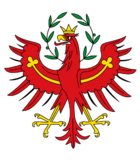Districts of Tirol
| Districts of Tirol Tiroler Distreć (Ladin) | |
|---|---|
 | |
| Category | District |
| Location | Tirol |
| Found in | Provinces (Provinzia) |
| Number | 34 (as of 2020) |
| Possible types |
|
| Subdivisions |
|
 |
|---|
| This article is part of a series on the politics and government of Tirol |
In Tiroler politics, a district (Ladin: Distret) is a second-level division of the executive arm of the country's government. District offices are the primary point of contact between resident and state for most acts of government that exceed municipal purview: marriage licenses, driver licenses, passports, assembly permits, hunting permits, or dealings with public health officers for example all involve interaction with the district administrative authority.
Tiroler constitutional law distinguishes two types of district administrative authority:
- district commissions (Distret Comiscïon), district administrative authorities that exist as stand-alone bureaus;
- statutory cities (Ziteies Statutar), cities that have been vested with district administration functions in addition to their municipal responsibilities, i.e. district administrative authorities that only exist as a secondary role filled by something that primarily is a city (marked in the table with an asterisk (*).
As of 2020, there are 34 districts, of which 28 are headed by district commissions; 5 are headed by statutory cities; and one, Innsbruck is a special autonomous district headed by the Innsbruck Metropolitan Council.
For brevity, government agencies often use the term "rural districts" (Distreć Rurèi) for districts headed by district commissions, although the expression does not appear in law and rural districts may have large urban populations, statutory cities are often referred to as metropolitan districts.
District commissions
A district headed by a district commission can cover between one-hundred and three-hundred municipalities. As a purely administrative unit, a district does not hold elections and therefore does not choose its own officials. The district governor is appointed by the provincial governor; the district civil servants are province employees.
Statutory cities
A statutory city is a city with both municipal and district administrative responsibility. Town hall personnel also serve as district personnel; the mayor also discharges the powers and duties of district commission. City management thus functions both as a regional government and a branch of the national government at the same time.
Most of the 5 statutory cities are major regional population centres with residents numbering at least 500,000. Technically any city with over 500,000 residents may demand to be elevated to a statutory city by its respective province, however no city has invoked this right since its establishment in 1893.
Innsbruck Autonomous District functions in a similar way to a statutory city, though it is a distinct subdivision due to its lack of association with any province. The legal basis for the autonomous district is enshrined in the constitution of Tirol which required the seat of the monarchy to be separated from the provinces to separate the interests of national government and the dominant region, Provinzia Inn.
